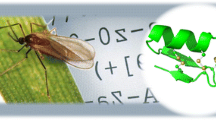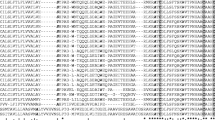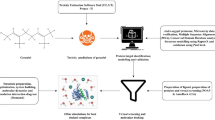Abstract
Dengue is a serious public health problem in tropical and subtropical countries. It is caused by any of the four serologically distinct dengue viruses, namely DENV1–4. The viruses are transmitted by Aedes mosquitoes. Understanding various defence mechanisms of insects has become a prime area of research worldwide. In insects, the first line of defence against invading pathogens includes cellular mechanisms and a battery of antimicrobial peptides such as defensins, cecropins etc. Defensins—cationic, cysteine-rich peptides consisting of ∼40 amino acids with broad-spectrum activity against Gram-positive bacteria—have been reported from a wide range of organisms. In the dengue vector mosquito, Aedes aegypti, three isoforms of defensins are reported to be expressed in a spatial and temporal fashion. This report presents the three-dimensional structures of the three isoforms of Ae. aegypti defensins predicted by comparative modeling. Prediction was done with Modeller 9v1 and the structures validated through a series of tests. The best results of the prediction study are presented, and may help lead to the discovery of new synthetic peptides or derivatives of defensins that could be useful in the control of vector-borne diseases.




Similar content being viewed by others
References
Halstead SB (2007) Dengue. Lancet 370:1644–1652. doi:10.1016/S0140-6736(07)61687-0
Gubler DJ (1998) Dengue and dengue haemorrhagic fever. Clin Microbiol Rev 11:480–496
Thenmozhi V, Hiriyan J, Tewari SC, Samuel PP, Paramasivan R, Rajendran R et al (2007) Natural vertical transmission of dengue virus in Aedes albopictus (Diptera: Culicidae) in Kerala, a Southern Indian state. Jpn J Infect Dis 60:245–249
Enserink M (2008) ENTOMOLOGY: a mosquito goes global. Science 320:954b. doi:10.1126/science.320.5878.954b. doi:10.1126/science.320.5878.864
Rezza G, Nicoletti L, Angelini R, Romi R, Finarelli AC, Panning M et al (2007) Infection with chikungunya virus in Italy: an outbreak in a temperate region. Lancet 370:1840–1846. doi:10.1016/S0140-6736(07)61779-6
Chakravarthi A, Kumaria R (2005) Eco-epidemiological analysis of dengue infection during an outbreak of dengue fever, India. Virol J 2:32. doi:10.1186/1743-422X-2-32
Hoffmann JA, Kafatos FC, Janeway CA Jr, Ezekowitz RAB (1999) Phylogenetic perspectives in innate immunity. Science 248:1313–1318. doi:10.1126/science.284.5418.1313
Brogden KA (2005) Antimicrobial peptides: pore formers or metabolic inhibitors in bacteria. Nat Rev Microbiol 3:238–241. doi:10.1038/nrmicro1098
Lowenberger C (2001) Innate immune responses of Aedes aegypti. Insect Biochem Mol Biol 31:219–229. doi:10.1016/S0965-1748(00)00141-7
Leippe M (1999) Antimicrobial and cytolytic polypeptides of amoeboid protozoa–effector molecules of primitive phagocytes. Dev Comp Immunol 23:267–279. doi:10.1016/S0145-305X(99)00010-5
Lambert J, Keppi E, Dimarcq J-L, Wicker C, Reichhart J-M, Dunbar B et al (1989) Insect immunity: isolation from immune blood of the dipteran Phormia terranovae of two insect antibacterial peptides with sequence homology to rabbit lung macrophage bactericidal peptides. Proc Natl Acad Sci USA 86:262–266. doi:10.1073/pnas.86.1.262
Chalk R, Albuquerque CM, Ham PJ, Townson H (1995) Full sequence and characterization of two insect defensins: immune peptides from the mosquito Aedes aegypti. Proc R Soc Lond B Biol Sci 261(1361):217–221. doi:10.1098/rspb.1995.0139
Lowenberger C, Bulet P, Charlet M, Hetru C, Hodgeman B, Christensen BM et al (1995) Insect immunity: isolation of three novel inducible antibacterial defensins from the vector mosquito, Aedes aegypti. Insect Biochem Mol Biol 25(7):867–873. doi:10.1016/0965-1748(95)00043-U
Wade D, Boman A, Wahlin B, Drain CM, Andreu D, Boman HG et al (1990) All-D amino acid-containing channel-forming antibiotic peptides. Proc Natl Acad Sci USA 88:4761–4765. doi:10.1073/pnas.87.12.4761
Cociancich S, Ghazi A, Hetru C, Hoffmann JA, Letelliers L (1993) Insect defensin, an inducible antibacterial peptid forms voltage-dependent channels in Micrococcus luteus. J Biol Chem 268(26):19239–19245
Paramasivan R, Sivaperumal R, Dhananjeyan KJ, Thenmozhi V, Tyagi BK (2007) Prediction of 3-dimentional structure of salivary odorant binding protein-2 of Culex quinquefasciatus. In Silico Biol 7:1–6
Pham DQ-D (2000) Molecular modeling of insect ferritins. In Silico Biol 2:S31–44
Krishna Murthy HM, Clum S, Padmanabhan R (1999) Dengue virus NS3 serine protease. J Biol Chem 274(9):5573–5580. doi:10.1074/jbc.274.9.5573
Brinkworth RI, Fairlie DP, Leung D, Young PR (1999) Homology model of the dengue 2 virus NS3 protease: putative interactions with both substrate and NS2B cofactor. J Gen Virol 80:1167–1177
Nall TA, Chappell KJ, Stoermer MJ, Fang N-X, Tyndall JDA, Young PR et al (2004) Enzymatic characterization and homology model of a catalytically active recombinant West Nile Virus NS3 protease. J Biol Chem 279(47):48535–48542. doi:10.1074/jbc.M406810200
Chappell KJ, Nall TA, Stoermer MJ, Fang N-X, Tyndall JDA, Fairlie DP et al (2005) Site-directed mutagenesis and kinetic studies of the West Nile Virus NS3 protease identify key enzyme-substrate interactions. J Biol Chem 280(4):2896–2903. doi:10.1074/jbc.M409931200
Vijayasri S, Agrawal S (2005) Domain based homology modeling and mapping of the conformational epitopes of envelope glycoprotein of West Nile virus. J Mol Model 11(3):248–255. doi:10.1007/s00894-005-0272-7
Zhou H, Singh NJ, Kim KS (2006) Homology modeling and molecular dynamics study of West Nile Virus NS3 protease: A molecular basis for the catalytic activity increased by the NS2B cofactor. Proteins 65:692–701. doi:10.1002/prot.21129
Baker D, Sali A (2001) Protein Structure Prediction and Structural Genomics. Science 294:93–96. doi:10.1126/science.1065659
Schibli DJ, Hunter HN, Aseyev V, Starner TD, Wiencek JM, McCray Jr. PB, Tack BF, Vogel HJ (2002) The solution structures of the human beta-defensins lead to a better understanding of the potent bactericidal activity of HBD3 against Staphylococcus aureus. J Biol Chem 277:8279–8289
Cociancich S, Clarke DJ, Polfer NC, Barran PE, Langley RJ, Govan JRW et al (2004) Structure-activity relationships in defensin dimers. J Biol Chem 279(47):48671–48679. doi:10.1074/jbc.M404690200
Suresh A, Verma C (2006) Modelling study of dimerization in mammalian defensins. BMC Bioinformatics 7(Suppl 5):S17. doi:10.1186/1471-2105-7-S5-S17
Altschul SF, Gish W, Miller W, Myers EW, Lipman DJ (1990) Basic local alignment search tool. J Mol Biol 215:403–410
Thompson JD, Higgins DG, Gibson TJ (1994) CLUSTAL W: improving the sensitivity of progressive multiple sequence alignment through sequence weighting, positions-specific gap penalties and weight matrix choice. Nucleic Acids Res 22:4673–4680. doi:10.1093/nar/22.22.4673
Higgins DG, Thompson JD, Gibson TJ (1996) Using CLUSTAL for multiple sequence alignments. Methods Enzymol 266:383–402. doi:10.1016/S0076-6879(96)66024-8
Felsentein J (2004) PHYLIP (Phylogeny Inference Package) version 3.6. Distributed by the author. Department of Genomic Studies, University of Washington, Seattle.
Jones DT, Taylor WR, Thornton JM (1992) The rapid generation of mutation data matrices from protein sequences. Comput Appl Biosci 8:275–282
Sali A, Blundell TL (1993) Comparative protein modelling by satisfaction of spatial restraints. J Mol Biol 234:779–815. doi:10.1006/jmbi.1993.1626
Marti-Renom MA, Stuart A, Fiser A, Sánchez R, Melo F, Sali A (2000) Comparative protein structure modeling of genes and genomes. Annu Rev Biophys Biomol Struct 29:291–325. doi:10.1146/annurev.biophys.29.1.291
Laskowski RA, MacArthur MW, Moss DS, Thornton JM (1993) PROCHECK: a program to check the stereochemical quality of protein structures. J Appl Cryst 26:283–291. doi:10.1107/S0021889892009944
Godzik A, Kolinski A, Skolnick J (1995) Are proteins ideal mixtures of amino acids? Analysis of energy parameter sets. Protein Sci 4(10):2107–2117
Godzik A (1996) Knowledge-based potentials for protein folding: what can we learn from known protein structures? Structure 4(4):363–366. doi:10.1016/S0969-2126(96)00041-X
Pawlowski K, Jaroszewski L, Bierzynski A, Godzik A (1997) Multiple model approach-dealing with alignment ambiguities in protein modeling. Pac Symp Biocomput 1997:328–339
Jaroszewski L, Pawlowski K, Godzik A (1998) Multiple model approach: exploring the limits of comparative modeling. J Mol Model 4:294–309. doi:10.1007/s008940050087
Cornet B, Bonmatin JM, Hetru C, Hoffmann JA, Ptak M, Vovelle F (1995) Refined three-dimensional solution structure of insect defensin A. Structure 3:435–448. doi:10.1016/S0969-2126(01)00177-0
Hanzawa H, Shimada I, Kuzuhara T, Komano H, Kohda D, Inagaki F et al (1990) 1H nuclear magnetic resonance study of the solution conformation of an antibacterial protein, sapecin. FEBS Lett 269:413–420. doi:10.1016/0014-5793(90)81206-4
DeLano WL (2002) The PyMOL molecular graphics system. DeLano, San Carlos, CA
Krieger E, Nabuurs SB, Vriend G (2003) Homology modeling. In: Bourne PE, Weissig H (eds) Structural bioinformatics. Wiley-Liss, New York, pp 507–521
Hancock REW, Chapple DS (1999) Peptide antibiotics. Antimicrob Agents Chemother 43:1317–1323
Author information
Authors and Affiliations
Corresponding author
Rights and permissions
About this article
Cite this article
Dhananjeyan, K.J., Sivaperumal, R., Paramasivan, R. et al. In-silico homology modeling of three isoforms of insect defensins from the dengue vector mosquito, Aedes aegypti (Linn., 1762). J Mol Model 15, 507–514 (2009). https://doi.org/10.1007/s00894-008-0408-7
Received:
Accepted:
Published:
Issue Date:
DOI: https://doi.org/10.1007/s00894-008-0408-7




